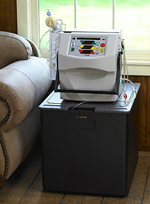 |
| Courtesy of WGCL-TV (CBS) Atlanta |
Introduced by a mutual friend, Horace and Schelorrey bonded over the disease and medical treatment they had in common. Both required weekly hemodialysis—treatment for kidney failure requiring a machine to purify the blood.
After five years of meeting at the center for lengthy dialysis sessions, three times each week, the two eventually got married.
“We had a lot to talk about regarding how things were going at the center,” Schelorrey says.
“We both understand what the other is going through like no one else can,” Horace adds. “She keeps me on track and makes sure I’m doing what I’m supposed to with my treatments.”
Ironically, the couple’s courtship was punctuated by what many would perceive as extremely unromantic quality-of-life issues. Both experienced debilitating bouts of weakness and exhaustion from the rigors of their dialysis treatment.
“I was very drained and weak and had to pretty much go to bed after treatment,” Schelorrey says. Her treatment schedule forced her to change her status from a full-time car salesperson to part-time worker.
Horace, who worked part time as a children’s basketball coach during the day, was so drained after his morning treatment that many times he missed work.
Despite their tiring treatment schedule, however, the couple’s relationship remained on track and the two were married in June 2006. Both felt happy that the center had brought them together.
Then Horace’s doctor mentioned a new portable dialysis machine—the NxStage System One—that would allow them to do at-home treatments.
 |
| NxStage System One |
But after two weeks of training, the couple’s car broke down. To help, the center shipped everything they needed to their home and the two were able to read a manual, assemble and use the unit without a problem.
“Everything is color-coded; it’s very user-friendly,” Schelorrey says. “You have an on-call person who is with your home-care facility. They are available 24/7.”
The most immediate benefit the two experienced, says Schelorrey, was a return of control over their lives. The NxStage decreased the amount of time they spent on dialysis. Plus the unit enabled the couple to schedule their treatments when it was convenient for them. “Now, it’s not when they [the center] want me there,” Schelorrey says. “I’m the one who chooses the best time for me to do my dialysis.”
For Horace, the NxStage provides the versatility he needs to go to work in the morning and do his dialysis treatments in the evenings. “Now, I can do more stuff,” he says.
The couple’s doctors recommended a minimum of five treatments a week for them. In general, doctors advise that “more frequent dialysis treatments better mimic natural kidney function, providing clinical benefits.”
Horace and Schelorrey are among the 32 percent of African Americans who experience kidney failure. Home dialysis enabled this couple to free themselves from the time-consuming captivity of in-center dialysis treatments. At-home dialysis offers a quality-of-life improvement for many patients who are forced to undergo draining dialysis treatments at crowded centers. And yet at-home dialysis is news to many—including some medical professionals.
“A lot of people don’t know about it,” Horace observes. “A few times when I went for a hospital visit and told them that I’m on home dialysis, the health care workers looked at me like I’m crazy. Or they assumed I was on peritoneal dialysis,” he says, referring to the kind of dialysis most often performed at home—although instead of a machine, it uses the patient’s own abdominal membrane as a filter to clean the blood.
“There are a lot of people in the medical field who don’t know about at-home hemodialysis,” Horace stresses. “But word is starting to spread now.”
Schelorrey adds: “A lot of people don’t know about it, and when you tell them, they think you’re talking about the gigantic machine that they have in the center. The NxStage is actually the size of a fax machine.”
Developed by NxStage Medical Inc., a medical device company based in Lawrence, Massachusetts, the NxStage is described as the first truly portable hemodialysis system approved for home use by the U.S. Food & Drug Administration [FDA].
The unit is about the size of a 13-inch TV and weighs 70 pounds. Another plus is the fact that home dialysis in general and the NxStage are covered by health insurance plans (including Medicare), says George Nichols, head of the home dialysis program at Renal Care Partners in Sandy Springs, Georgia.
Nichols trained Horace and Schelorrey to use the device. “A great deal of support services are rendered [to the patient],” Nichols says. “Personal support from our nursing, dietary and social staff is provided 365 days a year, with 24-hour assistance from me and the NxStage Medical support services.”
Nichols is enthusiastic about the unit, which, he says, is contraindicated only for patients in critical care and those with extremely limited mobility.
Happy to help spread the news about NxStage to people who are prime candidates, Horace and Schelorrey want to tell them that there is a better way to manage their kidney failure treatment.
“If they are willing to be an active participant in their home care, then they can have a free lifestyle,” Schelorrey says. “We went to a [support] meeting, and people were talking about how they got their lives back. This man rode his motorcycle for the first time in a long time for thousands of miles, something he couldn’t do before he got on the NxStage.”
And then the talk returns to love.
“I don’t want to sound brassy,” Schelorrey continues, “but my husband and I, as far as being lovers, before the NxStage, our love life was next to nothing. Who has the energy when you’re totally drained [by in-center treatments]?
“Now, we have more energy to go and hang out with our kids and grandkids, and we have a better life,” Schelorrey adds. “We’re very thankful for that.”






Comments
Comments